Abstract
It has been shown that bacteria in a postantibiotic (PA) phase exposed to subinhibitory concentrations (sub-MICs) of antibiotics show a long delay before regrowth. This effect has been named the PA sub-MIC effect (PA SME). In the present study, we have used a new method to demonstrate this phenomenon. A computerized incubator for bacteria, Bioscreen C (Lab Systems, Helsinki, Finland), which incubates the bacteria, measures growth continuously by vertical photometry, processes the data, and provides a printout of the results was used. With this method, one may easily test several antibiotics against different bacteria for PA effects (PAEs), PA SMEs, and SMEs. In this study, the effects of benzylpenicillin against beta-hemolytic streptococci and pneumococci were examined. The bacteria were exposed to 2, 10, or 50x MIC for 2 h, washed and diluted, incubated in the Bioscreen C incubator, and then exposed to 0.1 to 0.9x MIC. The regrowth was monitored for 20 h. The PAE was calculated as the difference in the time required for the exposed and unexposed bacteria to grow to a defined point (A50) on the absorbance curve. A50 was defined as 50% of the maximum absorbance for the control cultures. The PA SMEs were calculated as the difference in the time required for the reexposed cultures and the unexposed controls to reach A50. The PAEs ranged between 0.6 and 3.2 h and varied little with the concentration used for the induction of the PAEs. At 0.2x MIC, the PA SMEs were 2 to 3 h longer than the PAEs. Higher sub-MICs increased this delay before regrowth. Most cultures exposed to sub-MICs alone were only slightly affected compared with the controls.
Full text
PDF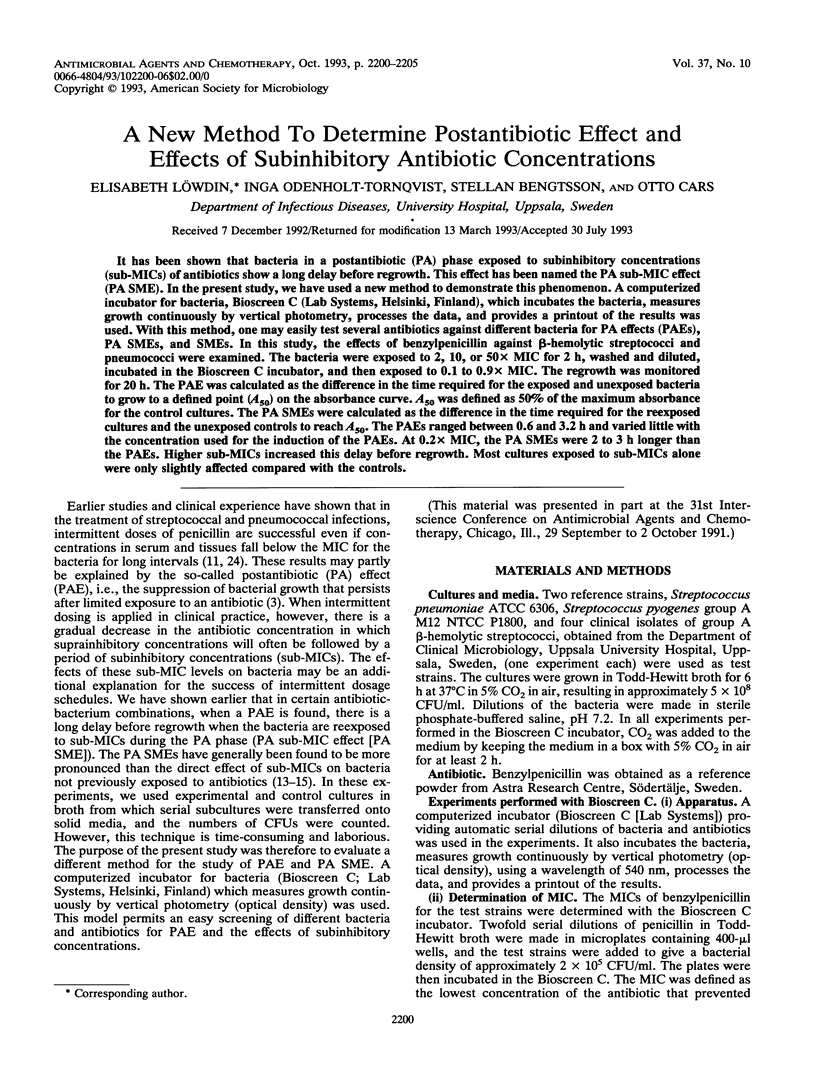
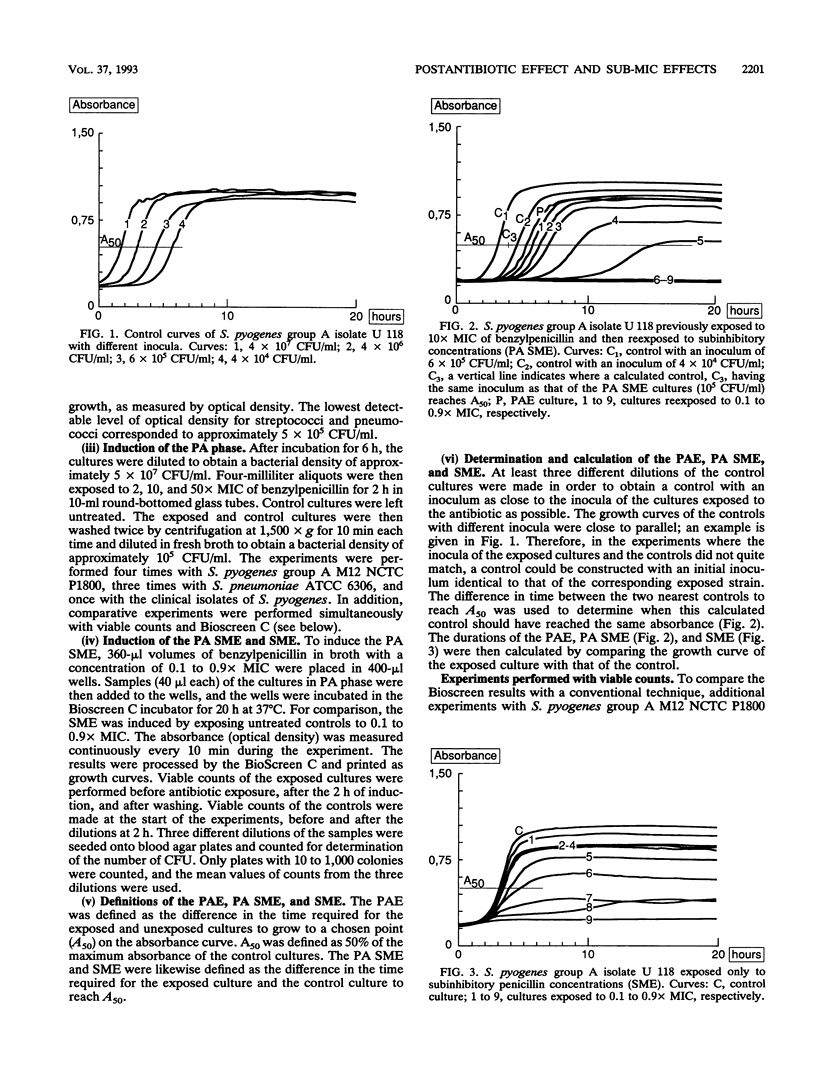
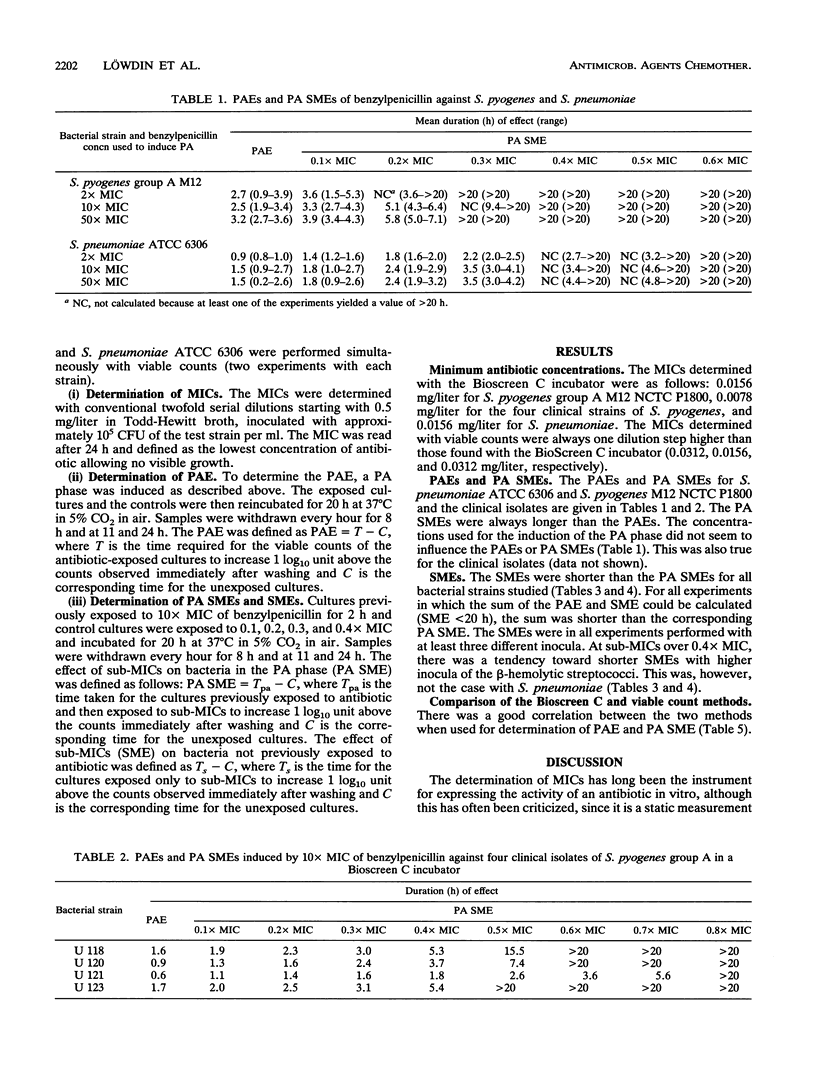
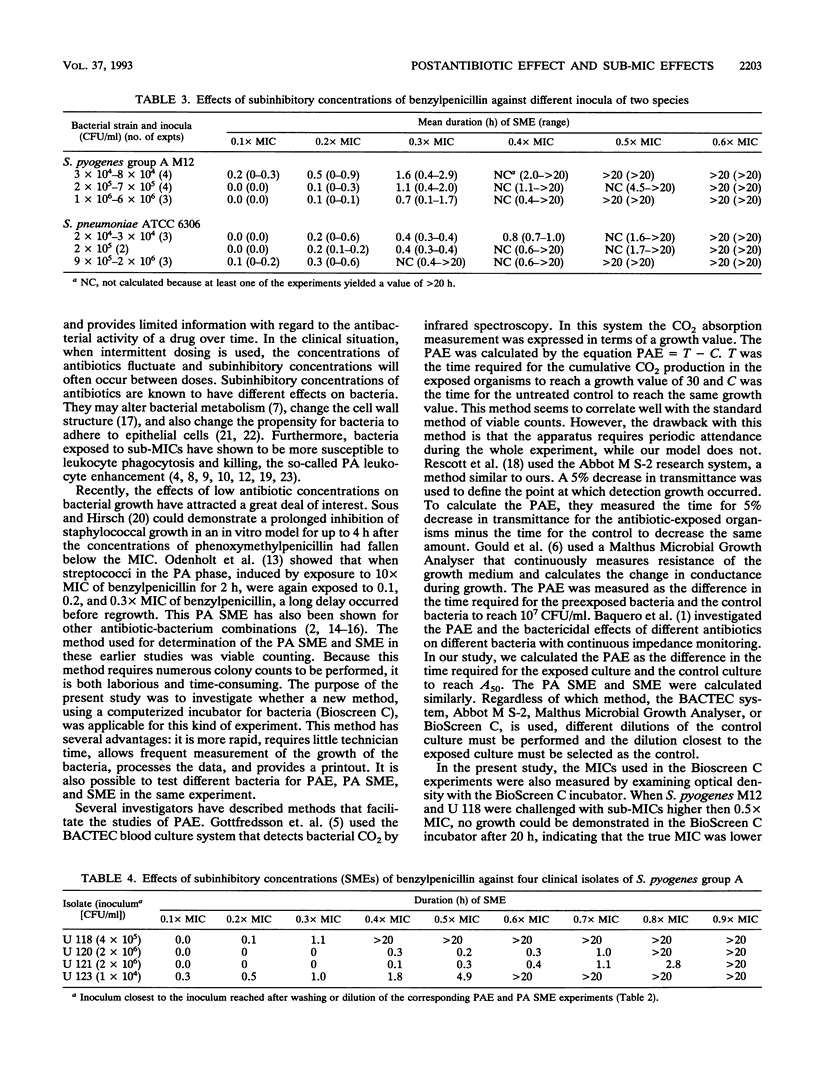
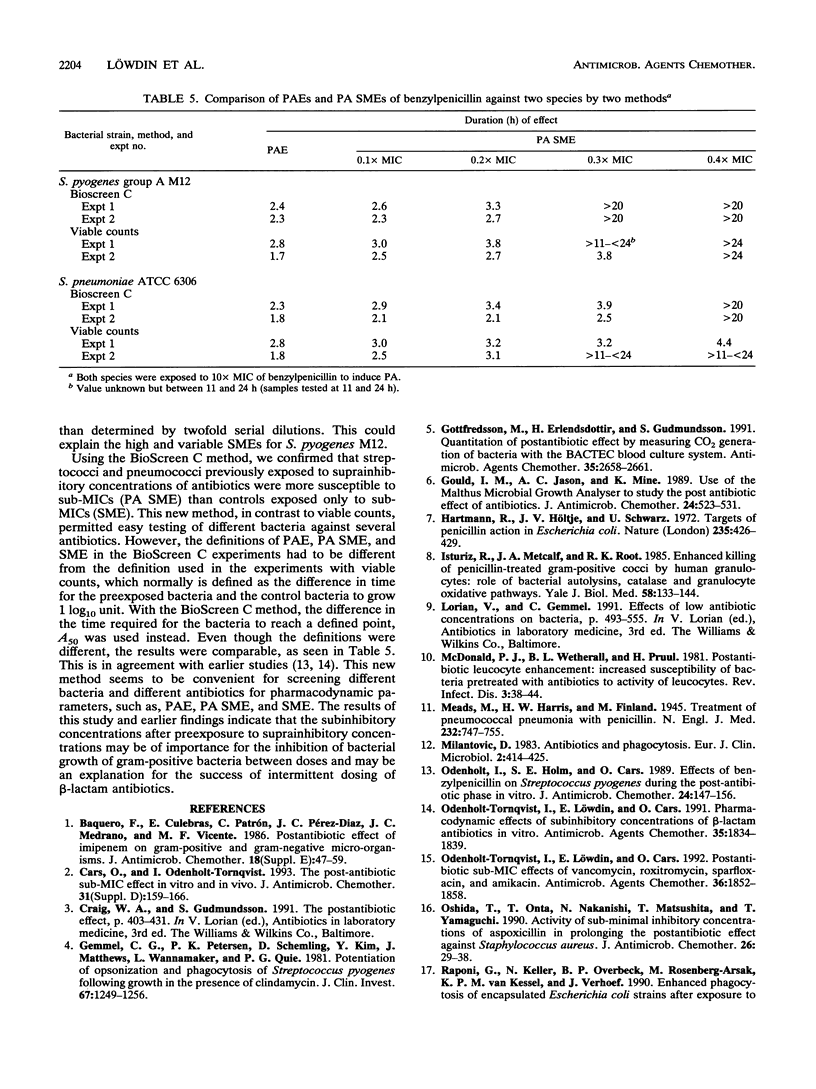
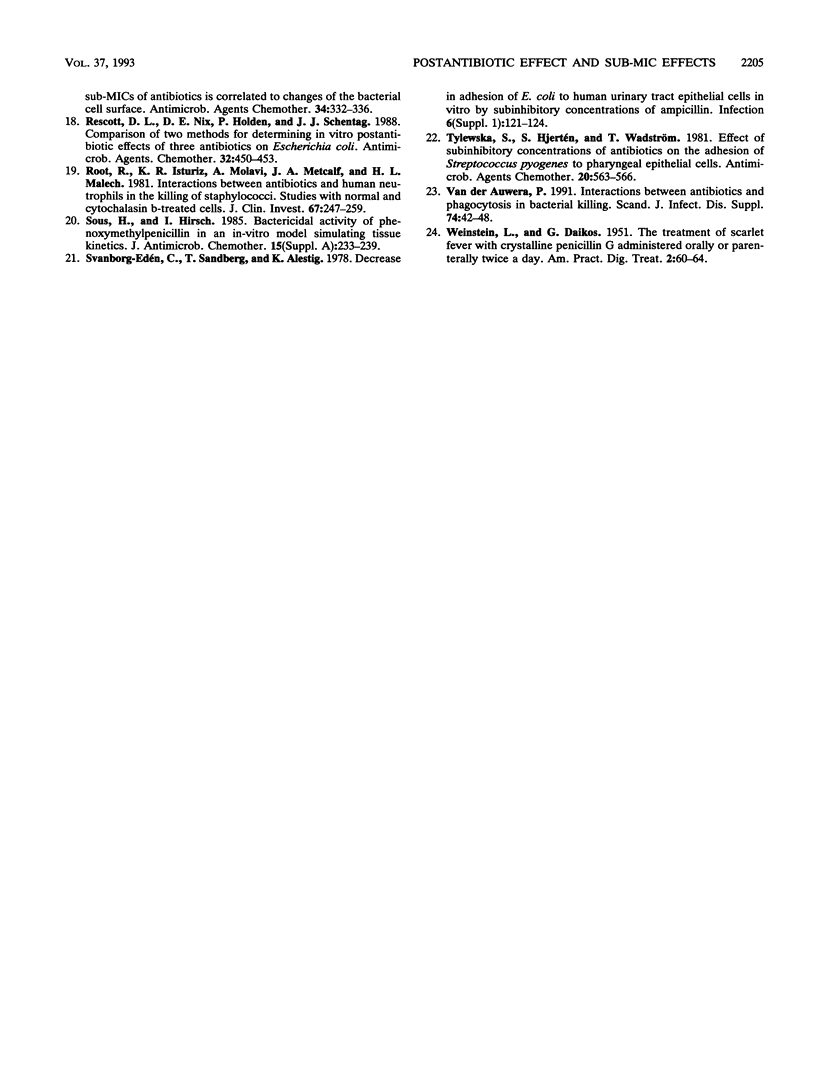
Selected References
These references are in PubMed. This may not be the complete list of references from this article.
- Baquero F., Culebras E., Patrón C., Pérez-Díaz J. C., Medrano J. C., Vicente M. F. Postantibiotic effect of imipenem on gram-positive and gram-negative micro-organisms. J Antimicrob Chemother. 1986 Dec;18 (Suppl E):47–59. doi: 10.1093/jac/18.supplement_e.47. [DOI] [PubMed] [Google Scholar]
- Cars O., Odenholt-Tornqvist I. The post-antibiotic sub-MIC effect in vitro and in vivo. J Antimicrob Chemother. 1993 May;31 (Suppl 500):159–166. doi: 10.1093/jac/31.suppl_d.159. [DOI] [PubMed] [Google Scholar]
- Gemmell C. G., Peterson P. K., Schmeling D., Kim Y., Mathews J., Wannamaker L., Quie P. G. Potentiation of opsonization and phagocytosis of Streptococcus pyogenes following growth in the presence of clindamycin. J Clin Invest. 1981 May;67(5):1249–1256. doi: 10.1172/JCI110152. [DOI] [PMC free article] [PubMed] [Google Scholar]
- Gottfredsson M., Erlendsdottir H., Gudmundsson S. Quantitation of postantibiotic effect by measuring CO2 generation of bacteria with the BACTEC blood culture system. Antimicrob Agents Chemother. 1991 Dec;35(12):2658–2661. doi: 10.1128/aac.35.12.2658. [DOI] [PMC free article] [PubMed] [Google Scholar]
- Gould I. M., Jason A. C., Milne K. Use of the Malthus Microbial Growth Analyser to study the post antibiotic effect of antibiotics. J Antimicrob Chemother. 1989 Oct;24(4):523–531. doi: 10.1093/jac/24.4.523. [DOI] [PubMed] [Google Scholar]
- Hartmann R., Höltje J. V., Schwarz U. Targets of penicillin action in Escherichia coli. Nature. 1972 Feb 25;235(5339):426–429. doi: 10.1038/235426a0. [DOI] [PubMed] [Google Scholar]
- Isturiz R., Metcalf J. A., Root R. K. Enhanced killing of penicillin-treated gram-positive cocci by human granulocytes: role of bacterial autolysins, catalase, and granulocyte oxidative pathways. Yale J Biol Med. 1985 Mar-Apr;58(2):133–143. [PMC free article] [PubMed] [Google Scholar]
- McDonald P. J., Wetherall B. L., Pruul H. Postantibiotic leukocyte enhancement: increased susceptibility of bacteria pretreated with antibiotics to activity of leukocytes. Rev Infect Dis. 1981 Jan-Feb;3(1):38–44. doi: 10.1093/clinids/3.1.38. [DOI] [PubMed] [Google Scholar]
- Milatovic D. Antibiotics and phagocytosis. Eur J Clin Microbiol. 1983 Oct;2(5):414–425. doi: 10.1007/BF02013898. [DOI] [PubMed] [Google Scholar]
- Müller H. E. Uber das unterschiedliche pathogenetische Verhalten in 171 Salmonella-Serotypen aufgrund ihres Vorkommens in Futtermitteln, Nutztieren und beim Menschen. Infection. 1978;6(3):121–129. doi: 10.1007/BF01642260. [DOI] [PubMed] [Google Scholar]
- Odenholt-Tornqvist I., Löwdin E., Cars O. Pharmacodynamic effects of subinhibitory concentrations of beta-lactam antibiotics in vitro. Antimicrob Agents Chemother. 1991 Sep;35(9):1834–1839. doi: 10.1128/aac.35.9.1834. [DOI] [PMC free article] [PubMed] [Google Scholar]
- Odenholt-Tornqvist I., Löwdin E., Cars O. Postantibiotic sub-MIC effects of vancomycin, roxithromycin, sparfloxacin, and amikacin. Antimicrob Agents Chemother. 1992 Sep;36(9):1852–1858. doi: 10.1128/aac.36.9.1852. [DOI] [PMC free article] [PubMed] [Google Scholar]
- Odenholt I., Holm S. E., Cars O. Effects of benzylpenicillin on Streptococcus pyogenes during the postantibiotic phase in vitro. J Antimicrob Chemother. 1989 Aug;24(2):147–156. doi: 10.1093/jac/24.2.147. [DOI] [PubMed] [Google Scholar]
- Oshida T., Onta T., Nakanishi N., Matsushita T., Yamaguchi T. Activity of sub-minimal inhibitory concentrations of aspoxicillin in prolonging the postantibiotic effect against Staphylococcus aureus. J Antimicrob Chemother. 1990 Jul;26(1):29–38. doi: 10.1093/jac/26.1.29. [DOI] [PubMed] [Google Scholar]
- Raponi G., Keller N., Overbeek B. P., Rozenberg-Arska M., van Kessel K. P., Verhoef J. Enhanced phagocytosis of encapsulated Escherichia coli strains after exposure to sub-MICs of antibiotics is correlated to changes of the bacterial cell surface. Antimicrob Agents Chemother. 1990 Feb;34(2):332–336. doi: 10.1128/aac.34.2.332. [DOI] [PMC free article] [PubMed] [Google Scholar]
- Rescott D. L., Nix D. E., Holden P., Schentag J. J. Comparison of two methods for determining in vitro postantibiotic effects of three antibiotics on Escherichia coli. Antimicrob Agents Chemother. 1988 Apr;32(4):450–453. doi: 10.1128/aac.32.4.450. [DOI] [PMC free article] [PubMed] [Google Scholar]
- Root R. K., Isturiz R., Molavi A., Metcalf J. A., Malech H. L. Interactions between antibiotics and human neutrophils in the killing of staphylococci. J Clin Invest. 1981 Jan;67(1):247–259. doi: 10.1172/JCI110020. [DOI] [PMC free article] [PubMed] [Google Scholar]
- Sous H., Hirsch I. Bactericidal activity of phenoxymethylpenicillin in an in-vitro model simulating tissue kinetics. J Antimicrob Chemother. 1985 Jan;15 (Suppl A):233–239. doi: 10.1093/jac/15.suppl_a.233. [DOI] [PubMed] [Google Scholar]
- Tylewska S., Hjertén S., Wadström T. Effect of subinhibitory concentrations of antibiotics on the adhesion of Streptococcus pyogenes to pharyngeal epithelial cells. Antimicrob Agents Chemother. 1981 Nov;20(5):563–566. doi: 10.1128/aac.20.5.563. [DOI] [PMC free article] [PubMed] [Google Scholar]
- Van der Auwera P. Interactions between antibiotics and phagocytosis in bacterial killing. Scand J Infect Dis Suppl. 1990;74:42–48. [PubMed] [Google Scholar]
- WEINSTEIN L., DAIKOS G. The treatment of scarlet fever with crystalline penicillin G administered orally or parenterally twice a day. Am Pract Dig Treat. 1951 Jan;2(1):60–64. [PubMed] [Google Scholar]


